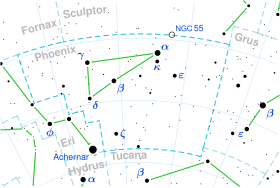| Observation data Epoch J2000 Equinox J2000 | |
|---|---|
| Constellation | Phoenix |
| Right ascension | 01h 28m 21.92727s[1] |
| Declination | −43° 19′ 05.6502″[1] |
| Apparent magnitude (V) | 3.41[2] |
| Characteristics | |
| Spectral type | M0III[3] |
| U−B color index | +1.85[4] |
| B−V color index | +1.57[4] |
| Variable type | Lb?[5] + β Lyr[6][7] |
| Astrometry | |
| Radial velocity (Rv) | +25.80[8] km/s |
| Proper motion (μ) | RA: −18.06[1] mas/yr Dec.: −208.63[1] mas/yr |
| Parallax (π) | 13.96 ± 0.34 mas[1] |
| Distance | 234 ± 6 ly (72 ± 2 pc) |
| Absolute magnitude (MV) | −0.86[2] |
| Orbit[9] | |
| Period (P) | 193.9 d |
| Semi-major axis (a) | 0.057[10][note 1]" (0.30 au) |
| Eccentricity (e) | 0.0301 |
| Inclination (i) | 46.3° |
| Longitude of the node (Ω) | 340.2[10]° |
| Periastron epoch (T) | 2453670.987 |
| Argument of periastron (ω) (secondary) | 136.8° |
| Semi-amplitude (K1) (primary) | −15.845 km/s |
| Details[6] | |
| Primary | |
| Mass | 1.3 M☉ |
| Radius | 50 – 55 R☉ |
| Luminosity | 562 L☉ |
| Temperature | 3,802 K |
| secondary | |
| Mass | 0.6 M☉ |
| Other designations | |
| Database references | |
| SIMBAD | data |
Gamma Phoenicis is a star system in the constellation Phoenix, located around 71.63 parsecs (233.6 ly) distant.[1]

γ Phoenicis is a spectroscopic binary and a small amplitude variable star. The star system shows regular variations in brightness that were reported as a 97.5 day period in the Hipparcos catalogue,[1] but have since been ascribed to a 194.1-day orbital period with primary and secondary minima.[11] Although the light curve appears to show eclipses, the high orbital inclination suggests the variations are due to ellipsoidal stars as they rotate in their orbit.[6] γ Phoenicis is listed in the General Catalogue of Variable Stars as a possible slow irregular variable with a range from 3.39 to 3.49, the same as reported for the eclipses or ellipsoidal variations.[5]
Only the primary star in the γ Phoenicis system is visible. The second is inferred solely from variations in the radial velocity of the primary star. The primary is a red giant of spectral type M0III, a star that has used up its core hydrogen, then expanded and cooled as it burns a shell of hydrogen around an inert helium core. The two stars are estimated to have masses of 1.3 M☉ and 0.6 M☉ respectively. The primary is over five hundred times more luminous than the sun. The system shows signs of hot coronal activity, although the primary star is too cool for this. It may originate on the secondary, possibly as material is accreted from the cool giant primary.[6]
- ^ a b c d e f g Cite error: The named reference
vanLeeuwen2007was invoked but never defined (see the help page). - ^ a b Cite error: The named reference
XHIPwas invoked but never defined (see the help page). - ^ Cite error: The named reference
Perkins1989was invoked but never defined (see the help page). - ^ a b Cite error: The named reference
MermiliodUBVwas invoked but never defined (see the help page). - ^ a b Cite error: The named reference
gcvswas invoked but never defined (see the help page). - ^ a b c d Cite error: The named reference
jorissenwas invoked but never defined (see the help page). - ^ Cite error: The named reference
magnitudwas invoked but never defined (see the help page). - ^ Cite error: The named reference
Evans1967was invoked but never defined (see the help page). - ^ Cite error: The named reference
orbitwas invoked but never defined (see the help page). - ^ a b Cite error: The named reference
Jancartwas invoked but never defined (see the help page). - ^ a b Cite error: The named reference
Oterowas invoked but never defined (see the help page).
Cite error: There are <ref group=note> tags on this page, but the references will not show without a {{reflist|group=note}} template (see the help page).
